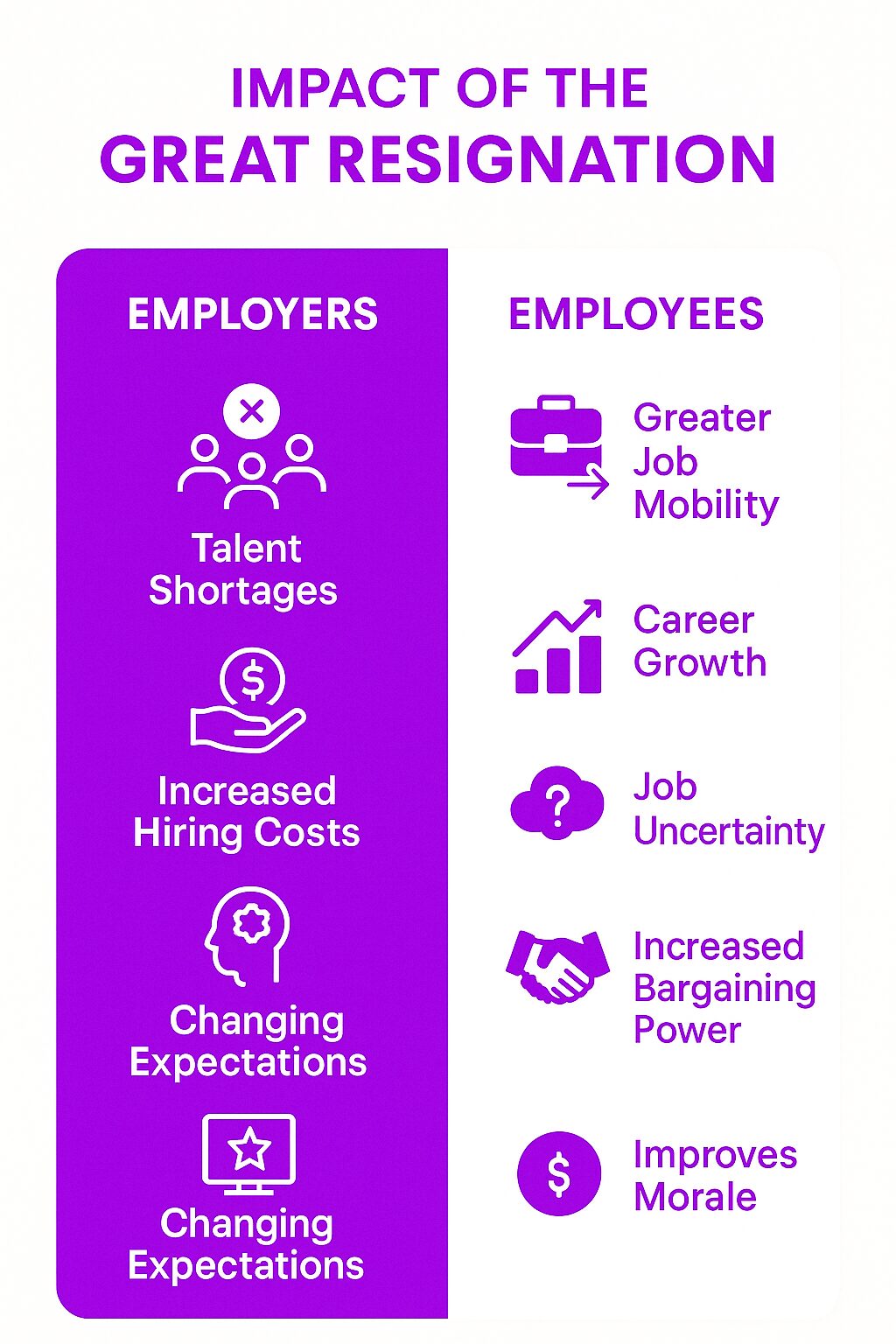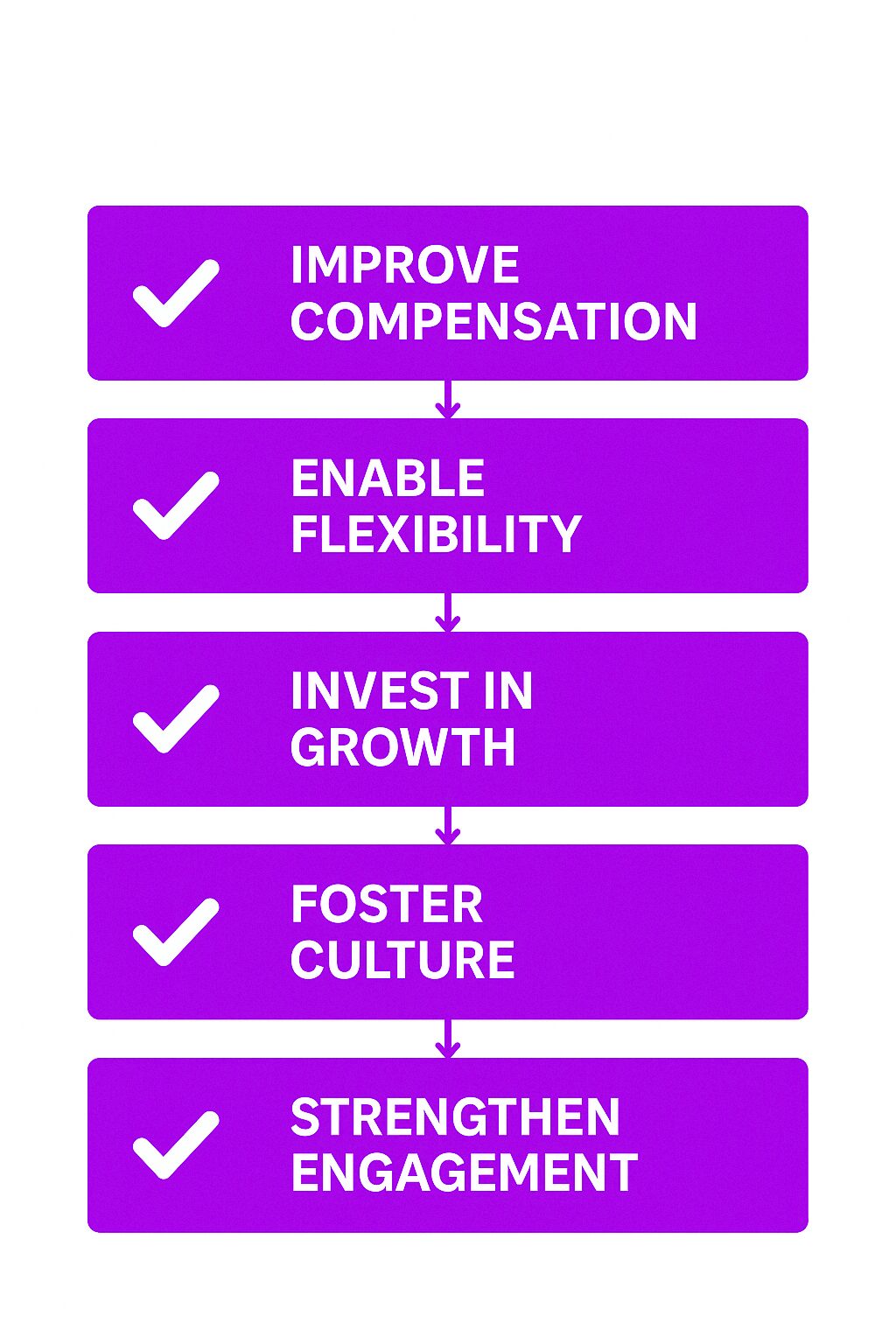What Is the Great Resignation?
The Great Resignation refers to a widespread trend where employees voluntarily left their jobs in record numbers. This movement gained attention in 2021 when millions of Americans quit their jobs during the pandemic, reshaping the workforce and changing employer-employee dynamics. While the trend was most visible in the United States, it also impacted global labor markets. The reasons behind this shift vary, but many workers left jobs in search of better pay, flexibility, and a healthier work-life balance. The Great Resignation also highlighted significant trends within the global workforce, revealing how employee sentiments and intentions to change jobs evolved worldwide.
Historical Context
The Great Resignation is not an isolated phenomenon but rather the culmination of labor market trends that have been evolving over the past few decades. The COVID-19 pandemic acted as a catalyst, accelerating these trends and creating a perfect storm of worker dissatisfaction and turnover. To fully grasp the significance of the Great Resignation, it’s essential to delve into the historical context of labor market dynamics, labor turnover, and worker satisfaction.
Labor Market Trends
Over the past few decades, the labor market has undergone significant transformations. There has been a growing emphasis on flexibility, work-life balance, and job satisfaction. The rise of the gig economy and the increasing acceptance of remote work have led to a decline in traditional employment arrangements. More workers are now seeking non-traditional work setups that offer greater autonomy and flexibility. According to the Bureau of Labor Statistics, the labor force participation rate has been on a downward trend since 2000, with a notable decline during the pandemic. This shift reflects a broader change in worker priorities, with many valuing work-life balance and job satisfaction over job security.
Causes of the Great Resignation
Pandemic-Related Burnout
The COVID-19 pandemic intensified job-related stress for many employees. Essential workers faced long hours and unsafe conditions, while remote employees struggled with blurred boundaries between work and personal life. Many workers reconsidered their career choices, leading to a surge in resignations.
Remote Work and Flexibility
The pandemic showed that remote and hybrid work models were not only feasible but preferred by many employees. Workers who had a taste of flexibility were unwilling to return to rigid office environments. Companies that insisted on mandatory in-office work saw higher attrition rates.
Work-Life Balance and Career Priorities
The pandemic prompted employees to rethink their careers and personal lives. Some left high-stress jobs to seek more fulfilling work. Others chose self-employment, freelancing, or jobs that provided more autonomy.
Wage Stagnation and Inflation
Many employees realized their compensation had not kept pace with inflation. Some left their jobs for better pay, while others sought positions with stronger benefits, such as paid time off, healthcare, and retirement plans.
Generational Workforce Shifts
Younger employees, particularly Millennials and Gen Z, place a high value on workplace flexibility, company culture, and mental well-being. Many left jobs that did not align with their values, opting for employers that offered more purpose-driven work and better work-life integration.
Low Pay and Job Dissatisfaction
Persistent issues of low pay and job dissatisfaction have long plagued the labor market, particularly in industries such as accommodation and food services. According to the Pew Research Center, workers in these sectors are more likely to experience low wages, limited benefits, and poor working conditions. The COVID-19 pandemic has only exacerbated these issues, leading to widespread worker dissatisfaction and a surge in turnover. Many employees in these industries have reached a breaking point, opting to leave their jobs in search of better opportunities and improved working conditions.
Impact on Companies in the Labor Market
Talent Shortages
Industries such as healthcare, retail, and hospitality faced severe staffing shortages as employees quit in droves. This forced employers to raise wages, improve benefits, and offer hiring incentives.
Increased Hiring and Training Costs
Replacing employees is expensive. Businesses had to invest more in recruitment, onboarding, and training to fill vacant positions. Some companies struggled to attract new talent due to reputational damage from high turnover rates.
Loss of Institutional Knowledge
When experienced employees left, companies lost valuable knowledge and expertise. In many cases, replacements took months to onboard, reducing overall efficiency.
Shift in Workplace Expectations
Employees began expecting more from their employers. Competitive salaries were no longer enough—workers demanded flexible schedules, career growth opportunities, and inclusive workplace cultures. Companies that failed to meet these expectations saw continued resignations.
How Employees Have Been Affected
Greater Job Mobility
A tight labor market gave employees more leverage. Many were able to negotiate higher salaries, better benefits, and remote work options.
Increased Competition
While many workers found better opportunities, others faced stiff competition, particularly in industries where resignations outpaced hiring.
Job Uncertainty
Some employees left their jobs without securing another one. Those who struggled to find new positions experienced financial stress and uncertainty.
Switched Jobs and Career Growth
Switching jobs has become a key strategy for workers seeking better pay, benefits, and working conditions. According to the Bureau of Labor Statistics, workers who switch jobs are more likely to experience significant wage growth and career advancement. However, the pandemic has disrupted traditional career paths, leading to a surge in workers seeking new opportunities and career growth. This trend underscores the importance of career mobility and the desire for professional development in today’s labor market.
Challenges for Employers
Retaining Talent
Companies needed to rethink retention strategies. Without addressing employee concerns, businesses risked losing more workers to competitors offering better conditions.
Adapting to Employee Expectations
Employers had to rethink outdated workplace policies. The shift toward flexible work arrangements required significant adjustments in management practices, performance evaluation, and team collaboration.
Addressing Burnout and Engagement
Employees who remained often took on heavier workloads due to staff shortages. This led to increased burnout, decreased morale, and, in some cases, additional resignations.
Strategies for Companies to Address the Great Resignation
Improve Compensation, Benefits, and Job Satisfaction
Competitive salaries and comprehensive benefits are essential for attracting and retaining talent. Companies that fail to offer fair compensation risk losing employees to better-paying competitors.
Enhance Workplace Flexibility
Hybrid and remote work options have become non-negotiable for many employees. Companies should assess which roles can be performed remotely and establish policies that accommodate flexible work arrangements.
Invest in Employee Growth
Career development programs, mentorship opportunities, and internal promotions help employees see a future within the company. Organizations that prioritize professional growth reduce turnover.
Build a Positive Work Culture
Toxic workplaces push employees out. Companies must focus on creating inclusive, respectful, and supportive environments. Leadership training and employee recognition programs play a key role in strengthening workplace culture.
Strengthen Employee Engagement and Communication
Clear, transparent communication fosters trust. Regular check-ins, town halls, and feedback sessions help employees feel heard. Recognition programs that highlight employee contributions boost morale and retention.
Related Workforce Trends
Quiet Quitting and Quit Rate
A trend where employees disengage from work but do not formally resign. Instead, they do the bare minimum to meet job expectations without investing extra effort.
The Great Reshuffle
Many employees did not leave the workforce entirely but instead switched industries or roles, seeking better career paths or working conditions.
The Gig Economy Surge
Some employees chose to leave traditional jobs in favor of freelancing or gig work, valuing autonomy over stability.
Industry Trends
Industry trends have played a significant role in the Great Resignation, with certain sectors experiencing higher rates of turnover and job dissatisfaction. Understanding these trends is crucial for employers aiming to retain workers and attract new talent.
Job Switching by Industry
Job switching has been particularly prevalent in industries such as food services, retail, and healthcare. According to the Bureau of Labor Statistics, workers in these sectors have been more likely to switch jobs in search of better pay, benefits, and working conditions. The quit rates in these industries have been notably high, reflecting widespread dissatisfaction among workers. Employers in these sectors must adapt to these trends by offering competitive compensation packages, flexible work arrangements, and opportunities for career growth. By addressing the root causes of turnover, companies can better retain their workforce and attract new talent in a competitive labor market.
Real-World Examples of Responses to the Great Resignation
Tech Companies Offering Remote-First Policies
Major tech firms like Twitter and Airbnb transitioned to permanent remote work models to retain talent. These companies recognized that forcing employees back into offices would lead to higher turnover.
Retailers Raising Wages
Retail giants such as Target and Walmart increased starting wages and introduced enhanced benefits to attract and retain workers in response to mass resignations.
Healthcare Industry Addressing Burnout
Hospitals and healthcare providers invested in mental health resources, flexible scheduling, and retention bonuses to combat the high exit rates of medical professionals.
Small Businesses Offering Unique Perks
Smaller companies, unable to compete on salary alone, started offering perks like unlimited PTO, four-day workweeks, and student loan repayment assistance to attract workers.
Lessons from the Great Resignation
The Great Resignation reshaped how businesses approach talent management. Employers who adapted to employee expectations—offering fair pay, flexible work, and career development—found it easier to retain workers. Companies that failed to make changes faced continued turnover.
For employees, the Great Resignation reinforced the importance of knowing one’s worth in the job market. Workers now have more leverage than ever in negotiating better conditions, career growth, and work-life balance. The workplace has permanently changed, and businesses that embrace these shifts will be better positioned for the future.







